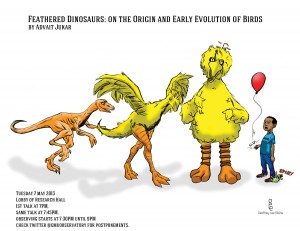The next talk as part of George Mason Observatory’s ‘Evenings Under the Stars’ series (where you’ll also get to look at awesome galaxies, stars, planets and more through our 0.8 meter telescope!) will be ‘Flying Dinosaurs: On the Origin and Early Evolution of Birds‘ by Advait Jukar. As always the event is free and everyone is invited (details about the event: Tuesday 7 May 2013: 1st talk at 7PM, same talk at 7:45PM, observing starts at 7:30PM until 9PM. Arrive at the lobby of Research Hall. )! Just keep an eye out for weather – the event may be postponed or cancelled due to bad conditions – updates will be available here – Observatory Twitter
A little about the upcoming talk:
Everyone has probably seen or heard of the film Jurassic Park by Steven Spielberg. It was one of the speakers’ favourite films growing up. However cool the dinosaurs were, the filmmakers got something wrong. They forgot to put feathers on the dinosaurs! Ever since the discovery of archaeopteryx in 1861, just a few years after Darwin published the Origin of Species, palaeontologists have become convinced that birds are the descendants of feathered dinosaurs. However, for a long time, archaeopteryx was the only dinosaur known with feathers. Then came the spectacular fossil finds from China that revealed a whole menagerie of feathered dinosaurs. This revolutionised our understanding of the evolution of the group of animals we call aves and how dinosaurs took to the air. Through this talk, Advait Jukar will present evidence that not all dinosaurs went extinct, but the chicken that you eat is in fact a relative of T-rex! He invites you to come on a fascinating journey with him through the evolutionary story of the group of dinosaurs that gave rise to modern birds. He will show you the new additions to this story since archaeopteryx and what scientists have discovered about the origin and evolution of avian flight.
And the speaker:
Advait Jukar was born and brought up in India. His passion for the natural world came from a very young age, but he was always fascinated with dinosaurs and fossils more than anything else. He used to be an avid collector of fossils in India before he moved to the United States to pursue higher education. He earned his BA in Biology from Reed College in Oregon where he studied Korean frogs for his senior thesis. After that, he moved to Marshall University in West Virginia where he studied palaeontology under Dr. F Robin O’Keefe. He then moved to George Mason where he is pursuing a master’s degree and is studying ecological thresholds in coral reef ecosystems. Even though his primary field of study is not palaeontology anymore, he continues to work in the field. He is working with Dr. Matthew Carrano, the curator of dinosauria at the National Museum of Natural History and is classifying micro-vertebrate fossils that the famous palaeontologist O.C. Marsh discovered in the 1890s in Wyoming. These fossils are 66 million years old and belong to animals that lived just before the cretaceous mass extinction that wiped out most of the dinosaurs.
Directions to GMU and Research Hall here: http://eagle.gmu.edu/map/fairfax.php Zoom in to find Research Hall next to engineering building and York River Rd



 Additional questions and feedback on the Observatory site can be addressed to:
Additional questions and feedback on the Observatory site can be addressed to: